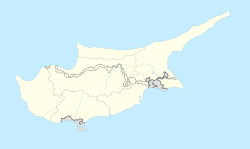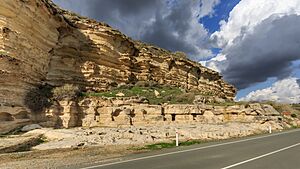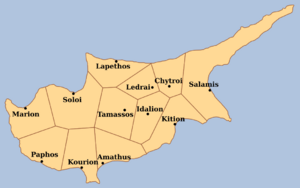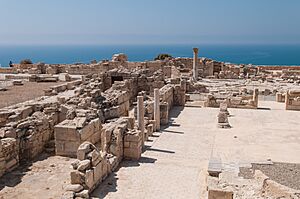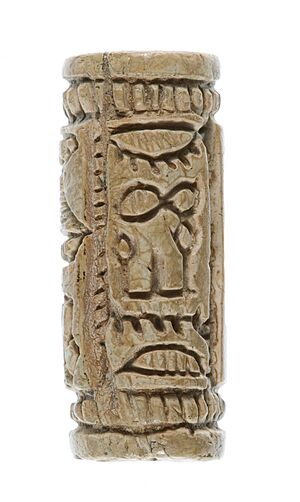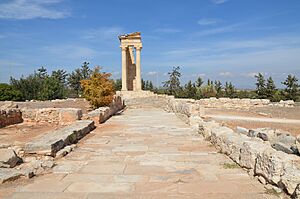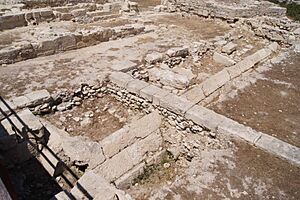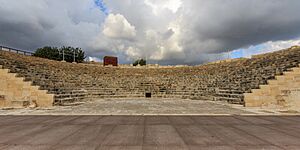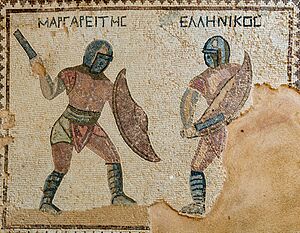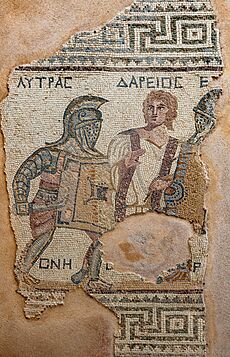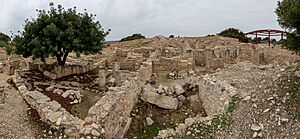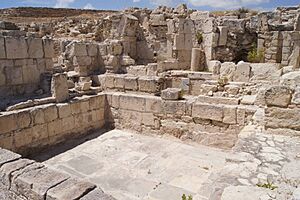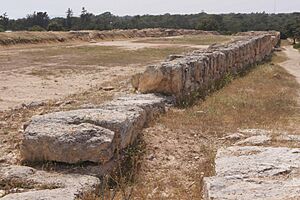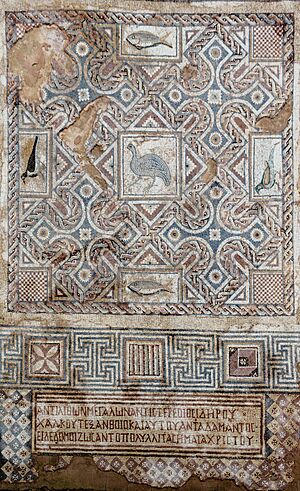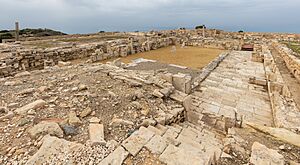Kourion facts for kids
|
Koύριov
|
|
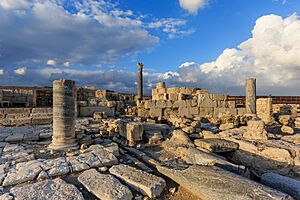
Kourion Agora
|
|
| Alternative name | Curium |
|---|---|
| Location | Episkopi, Limassol District, Cyprus Episkopi Cantonment, British Overseas Territory Of Akrotiri and Dhekelia |
| Coordinates | 34°39′51″N 32°53′16″E / 34.6642°N 32.8877°E |
| Type | Settlement |
| Site notes | |
| Excavation dates | 1875, 1895, 1934-1938, 1947-1954, 1956-1959, 1964-present |
| Archaeologists | Luigi Palma di Cesnola, H.B. Walters, G. McFadden, B.H. Hill, J. Daniel, A.H.S. Megaw, M.C. Loulloupis, David Soren, Thomas W. Davis |
| Management | Cyprus Department of Antiquities |
Kourion (also known as Koύριov in ancient Greek or Curium in Latin) was a very important ancient city. It was located on the southwest coast of the island of Cyprus. Around 1200 BCE, after big changes in the Mycenaean world, Greek people from Argos came and settled here.
In the 300s CE, Kourion was hit by five strong earthquakes. But the city was mostly rebuilt after these events. The main part of Kourion, called the acropolis, sits on a high limestone cliff. This cliff is almost 100 meters tall and overlooks Episkopi Bay.
Today, the Kourion archaeological site is in a British Overseas Territory called Akrotiri and Dhekelia. The Cyprus Department of Antiquities takes care of it.
Contents
- The Story of Kourion
- Discovering Kourion: The Excavations
- What Remains Today: Kourion's Ancient Buildings
- Sanctuary of Apollo Hylates
- Early Structures and Hellenistic Finds
- The Grand Theatre
- The Amathus Gate Cemetery
- Water for the City: Aqueducts
- The House of the Gladiators
- The House of Achilles
- The "Earthquake House"
- The Forum, Nymphaeum, and Public Baths
- The Stadium
- The House and Baths of Eustolios
- The Bishop's Area and Cathedral
- The Northwestern Basilica
- The Early Christian Beachfront Basilica
- See also
The Story of Kourion
Early Times in the Area
People first lived in the Kouris River valley a very long time ago. The oldest known settlement is Sotira-Teppes, dating back to the Ceramic Neolithic period (around 5500–4000 BCE). Another early village was Kandou-Kouphovounos.
Later, during the Chalcolithic period (3800–2300 BCE), people moved to Erimi-Pamboules. Life continued in this area through the Early Cypriot period (around 2300–1900 BCE).
By the Late Cypriot period (1600–1050 BCE), the small villages grew into busy towns. Episkopi-Bamboula became a very important center. It helped control the trade of Troodos copper. This town was very successful in the 1200s BCE before people left it around 1050 BCE.
The Kingdom of Kourion
Kourion became a powerful kingdom in Cyprus around 1050–750 BCE. We know this mostly from ancient burials found at the Kaloriziki necropolis. These tombs show that the community was growing richer and trading with mainland Greece.
Even when Cyprus was ruled by the Assyrians, Kourion remained one of the most important kingdoms. A king named Damasos of Kourion is mentioned in ancient records from 672 BCE.
Cyprus was also ruled by Egypt for a short time (569 to 546 BCE). Then, in 546 BCE, the Persian Empire, led by Cyrus I, took control of Cyprus and its kingdoms, including Kourion.
During a big revolt against the Persians (499–493 BCE), Stasanor, king of Kourion, first joined forces with other Cypriot kings. But then, Stasanor betrayed them in a battle against the Persian general Artybius. This led to the Persians winning and keeping control of Cyprus.
Later, during the Classical Period (475–333 BCE), the main part of Kourion, the acropolis, was settled. King Pasikrates of Kourion helped Alexander the Great in the siege of Tyre in 332 BCE. Pasikrates ruled under Alexander, but he was removed from power during the fights after Alexander's death. Around 294 BCE, the Ptolemies (rulers from Egypt) took control of Cyprus, and Kourion became part of their empire.
Roman Times in Kourion
In 58 BCE, the Romans took over Cyprus, making it a Roman province. For a short time (47 to 31 BCE), it was ruled by Marc Antony and Cleopatra VII, but then it went back to Roman control. In 22 BCE, Cyprus became its own Roman province.
Under the Romans, Kourion had its own local government. Records show that the city had elected officials, like an Archon (a main leader) and a council. Kourion likely thrived and its people had a good quality of life because of strong trade with the rest of the Roman Empire.
During the first to third centuries CE, many important people lived in Kourion. They honored emperors and city officials with special decrees. The city spent a lot on these honors, sometimes needing oversight from Roman officials.
People in Kourion also worshipped the Roman emperors, alongside their local gods like Apollo Hylates. Kourion was so important that several ancient writers mentioned it, including Ptolemy and Pliny the Elder.
During a time when Christians faced difficulties (the Diocletianic Persecution), Philoneides, the Bishop of Kourion, died for his faith. Later, in 341 CE, Bishop Zeno helped make sure the Cypriot church stayed independent.
In the late 300s CE (around 365-370 CE), Kourion was hit by five powerful earthquakes. These quakes caused huge damage, almost destroying the city. Kourion was rebuilt in the late 300s and early 400s, but some parts of the acropolis were left empty. The rebuilding included a large church area.
Around 648-649 CE, Arab raids destroyed the acropolis. After this, the main center of the city moved to Episkopi, about 2 km away. Episkopi was named after the Greek word for bishop, because the bishop's seat moved there.
Discovering Kourion: The Excavations
People first recognized the site of Kourion in the 1820s. Later, in the 1830s and 1840s, researchers found the Sanctuary of Apollo Hylates.
In 1874–1875, Luigi Palma di Cesnola, a consul, dug extensively at Kourion. He was mainly looking for valuable objects to sell, and many of his finds ended up in the Metropolitan Museum of Art.
After some uncontrolled digging, the British High Commissioner made private excavations illegal in 1887.
In 1895, led by H.B. Walters, the British Museum conducted the first more organized excavations at Kourion.
Later, from 1934 to 1938 and again from 1947 to 1954, the University Museum at the University of Pennsylvania carried out major digs. They worked mostly on the acropolis and in the cemeteries. They found important items like pots with ancient writing and the famous Kourion Sceptre.
Many other archaeologists have worked at Kourion over the years. These include A.H.S. Megaw, M.C. Loulloupis, Demos Christou, and David Soren. Since 2012, the Kourion Urban Space Project has continued to explore the acropolis. These excavations help us learn more about this amazing ancient city.
What Remains Today: Kourion's Ancient Buildings
The majority of the ancient buildings you can see at Kourion today are from the Roman period. This includes the time when the Roman Empire was strong and later when it was changing into the Byzantine Empire. The Cyprus Department of Antiquities manages and protects all these historical remains.
Sanctuary of Apollo Hylates
The Sanctuary of Apollo Hylates was a very important religious site. It was dedicated to Apollo, the god of light, music, and healing. This sanctuary was one of the most important in all of Cyprus.
The oldest finds here date back to the late 700s BCE. People left offerings to "the god" at an ancient altar. It wasn't until later, around the mid-200s BCE, that Apollo was clearly linked to the site.
The buildings you see today were mostly built in the 1st century CE. They were restored and expanded around 100 CE after an earthquake. This included a sacred street, a training area (palaestra), and a temple.
The temple was abandoned in the late 300s CE after another earthquake caused major damage.
Early Structures and Hellenistic Finds
The oldest buildings found on the acropolis date to the Late Cypro-Classical period (350–325 BCE). These include a large stone structure shaped like a pyramid, which might have been part of a fort. More ancient walls have been found along the northern edge of the acropolis.
Archaeologists also found parts of a large public building from the Hellenistic period (around 325 to 50 BCE). This building was about 30 meters long. Another discovery from this time was a beautiful black and white pebble mosaic.
The Grand Theatre
The theatre of Kourion was first built on a smaller scale in the late 100s BCE. It used the natural slope of the hill to support its seating area. This design was common for Greek theatres.
The theatre was repaired after an earthquake around 15 BCE. Later, around 64-65 CE, the stage building was rebuilt. The seating area was also changed to a Roman style, making it a half-circle.
A major renovation happened around 98–111 CE, making the theatre its current size. The stage building was made taller, blocking the view of the sea.
Between 214 and 217 CE, the theatre was even used for gladiatorial games and animal hunts! But it was changed back to a theatre after 250 CE.
The theatre was abandoned in the late 300s CE, probably because of more earthquakes. It could hold about 3,500 people. Today, the theatre has been restored and is used for performances, like the International Festival of Ancient Greek Drama.
The Amathus Gate Cemetery
This cemetery is located at the bottom of the cliffs, near the entrance to the archaeological site. It's one of the first things visitors see.
In ancient times, people would walk up a ramp to reach the Amathus gate. The cemetery was built on two levels along the cliffs.
From the 200s BCE to the 1st century CE, the Ayios Ermoyenis cemetery was the main burial ground for Roman Kourion. It had tombs carved into the rock, often with multiple rooms for many burials.
Later, from the late 300s to the 500s CE, new types of burials were made in the quarried rock.
Water for the City: Aqueducts
Even though Kourion is dry today, the city had a great water supply in Roman times. This is clear from the large public baths and fountains (nymphaeum) found there.
Two aqueducts brought water to Kourion from springs far away. One came from Sotira, about 11 km away, and the other from Souni, 20 km away. These aqueducts used thousands of clay pipes to carry the water.
The aqueduct from Souni was likely added later to provide even more water. Before these aqueducts were built, the city probably relied on rainwater stored in cisterns.
The House of the Gladiators
This building, called the House of the Gladiators, dates to the late 200s CE. It might have been a large private home or, more likely, a public training area (palaestra). It had a central courtyard with columns.
The most exciting part is the mosaics! They show gladiators fighting, and these are the only mosaics of gladiators found in Cyprus. The building was badly damaged by earthquakes in the late 300s CE.
The House of Achilles
The House of Achilles is located at the edge of the acropolis. It was built in the early 300s CE. It might have been a public reception hall for important visitors.
This building also has a central courtyard with columns. Some parts of its mosaic floors are still visible. One important mosaic shows the story of Achilles. It depicts how Odysseus revealed Achilles's identity when his mother had hidden him to keep him from going to war. Another room has a mosaic showing Thetis bathing Achilles. Another room has a mosaic with a mythological scene.
This building was also destroyed by the earthquakes in the late 300s CE.
The "Earthquake House"
This house is a powerful reminder of the earthquakes that hit Kourion around 365-370 CE. It shows exactly how the city was destroyed.
The house was built in the 1st or 2nd century CE and was changed over time. Its sudden destruction gives us a unique look into the lives of ordinary people in Kourion.
Archaeologists found the remains of people and animals exactly as they were when the earthquake struck. For example, they found the remains of a young person who fell from an upper floor. They also found a young adult woman with an infant, held by an adult male. The remains of a mule were found still chained in its stable.
This house was first found in the 1980s and is still being studied today.
The Forum, Nymphaeum, and Public Baths
The forum of Kourion was the main public square. It was built in the late 100s or early 200s CE. It had a central paved area surrounded by covered walkways with columns.
Shops lined the eastern side of the forum. The northern side led to a grand fountain building called a nymphaeum and a large public bath complex.
The nymphaeum was built in four stages from the early 1st century CE to the mid-600s CE. It was one of the largest fountains in the Roman world during the 2nd and 3rd centuries.
After being damaged by earthquakes in the late 300s, the nymphaeum was rebuilt. For a short time, it was even used as a temporary church. It was abandoned in the mid-600s.
The public baths, or thermae, were built around the nymphaeum in the early to mid-300s CE. They had different rooms for bathing, including a sudatorium (sweat room), a caldarium (hot room), and a tepidarium (warm room).
The Stadium
The stadium of Kourion was built during the Antonine period (around 138–180 CE). It was 187 meters long, with a starting line for eight runners.
The seating area was curved and had seven rows of seats. It could hold about 6,000 spectators! This is the only ancient stadium found in Cyprus.
The stadium was abandoned in the later half of the 300s CE.
The House and Baths of Eustolios
This large complex was built in the late 300s CE, right after an earlier building was destroyed. In the early 400s, a bathing complex was added.
The complex has over thirty rooms. An inscription at the entrance welcomes visitors, saying, "Enter for the good luck of the house."
The main part of the house is a courtyard with a central pool. Its walkways are decorated with beautiful mosaics. One mosaic tells us that Eustolios built this place to help the people of Kourion, likely after the earthquakes.
The inscription also shows that Eustolios was a Christian. The mosaics include images of fish and birds.
The bathing area had a frigidarium (cold room) with an antechamber, a tepidarium (warm room), and a caldarium (hot room). The frigidarium has a mosaic showing a figure representing "Creation."
This complex was used until it was destroyed in the mid-600s CE. It started as a private home but became a public bath facility.
The Bishop's Area and Cathedral
The main church (cathedral) and the bishop's area in Kourion were built in the early 400s CE. They were located on the cliffs southwest of the forum.
This cathedral, the seat (cathedra) of the Bishop of Kourion, was a large church with three aisles and a rounded end (apse). It was beautifully decorated with white marble walls and colorful mosaics on the floors. The altar was covered by a special canopy.
This area was built when Kourion was recovering from the devastating earthquakes. The fact that so many resources went into building this church shows how important Christianity had become in the city.
The area was destroyed during Arab raids in the 600s CE. After this, the bishop's seat moved inland.
The Northwestern Basilica
In the late 400s CE, another large church was built northwest of the acropolis. This church also had three aisles and three rounded ends.
Its floors were paved with marble slabs. The main apse had special seating for the clergy.
Visitors entered through a courtyard with columns and a main entrance hall. This church was abandoned in the mid-600s CE during the early Arab raids.
The Early Christian Beachfront Basilica
In the early 500s CE, an early Christian church was constructed at the base of the southwestern cliffs, near the unexcavated harbor area.
The church was a three-aisled basilica with three rounded ends. It measured about 27.5 meters long and 14 meters wide. Its altar faced southeast.
The central aisle and side aisles were paved with mosaics. A courtyard with columns was located to the west of the church. This courtyard had a baptistery (for baptisms) and a well in the center.
This church was abandoned in the mid-600s CE due to Arab raids on the coastal cities of Cyprus.
See also


